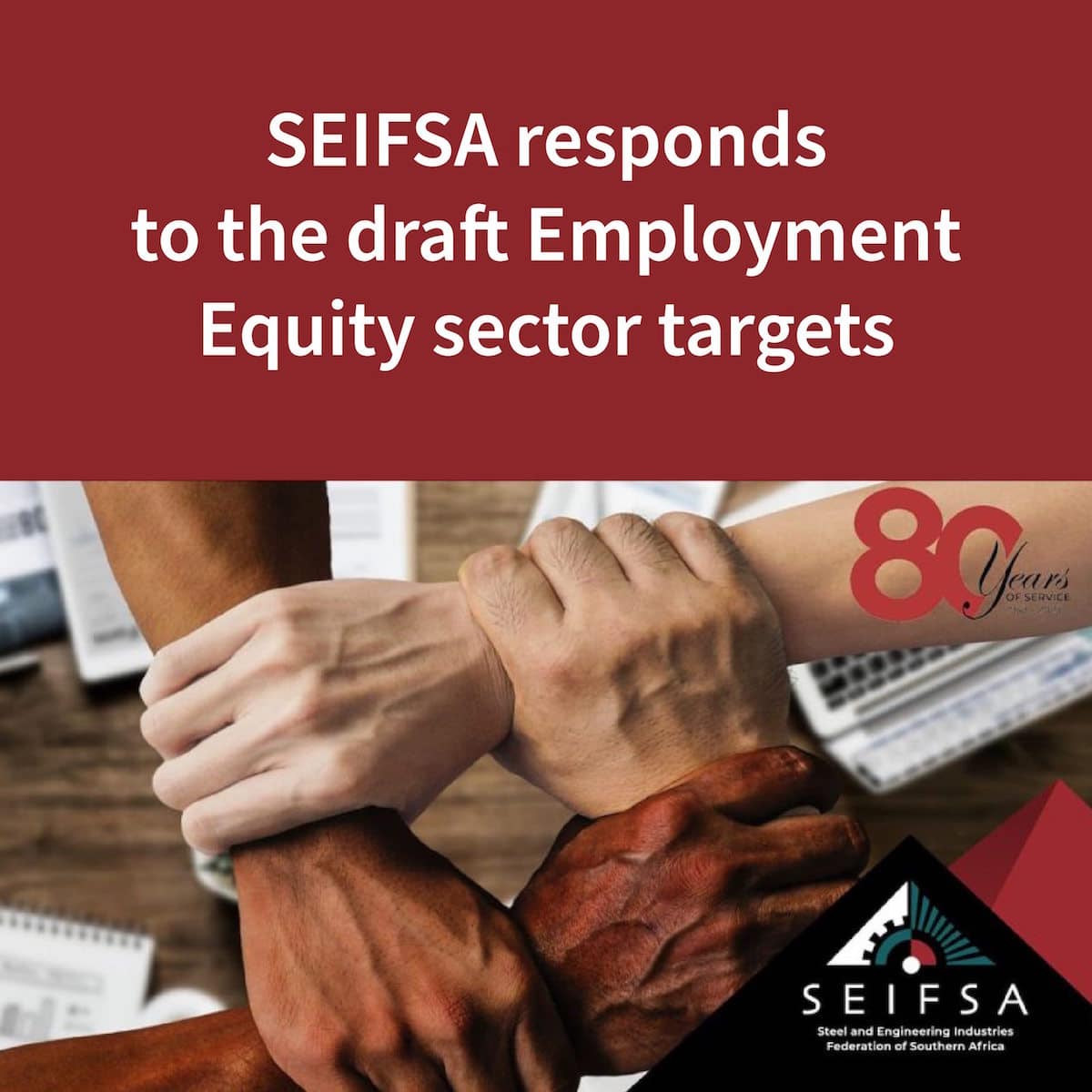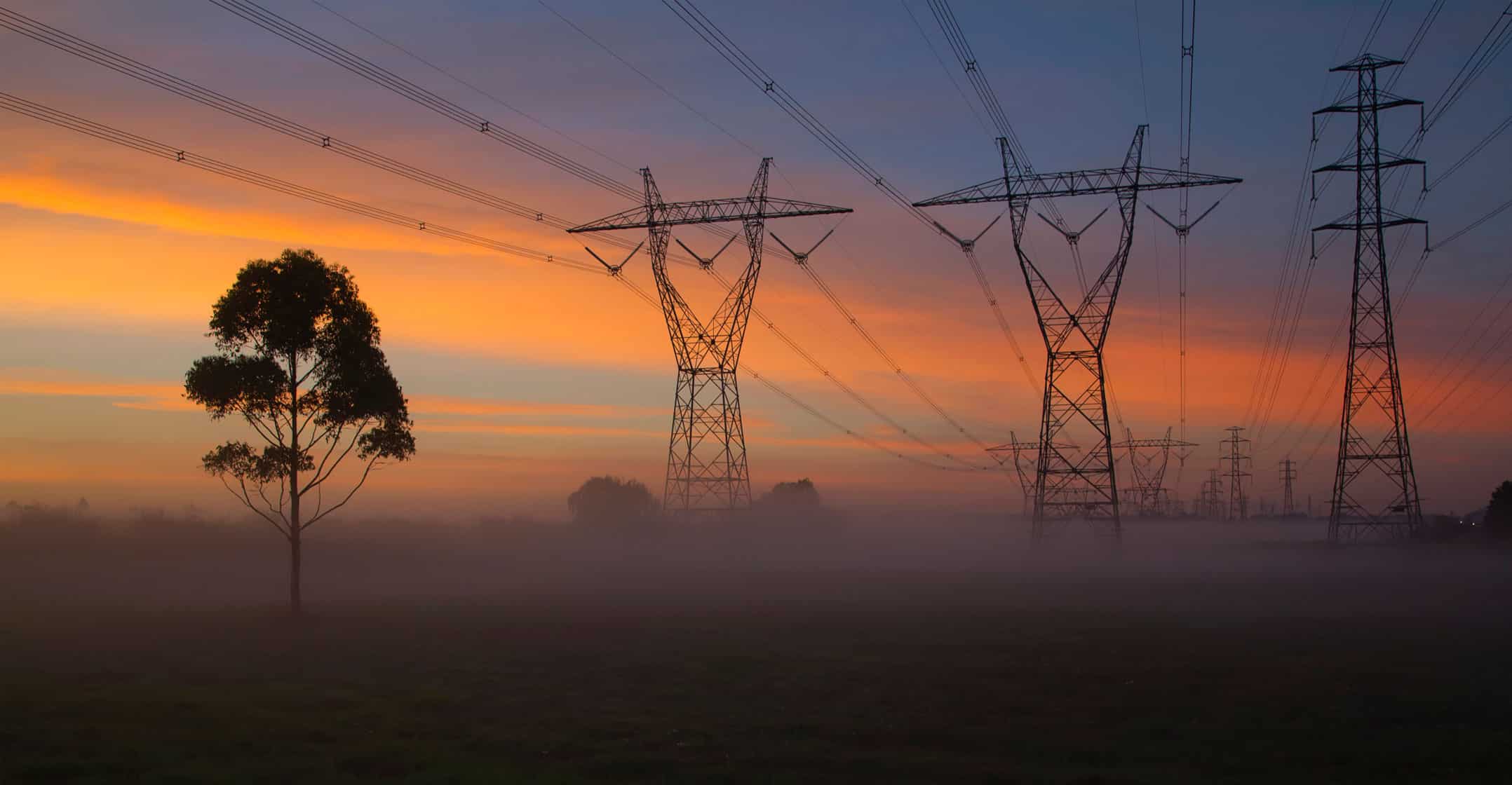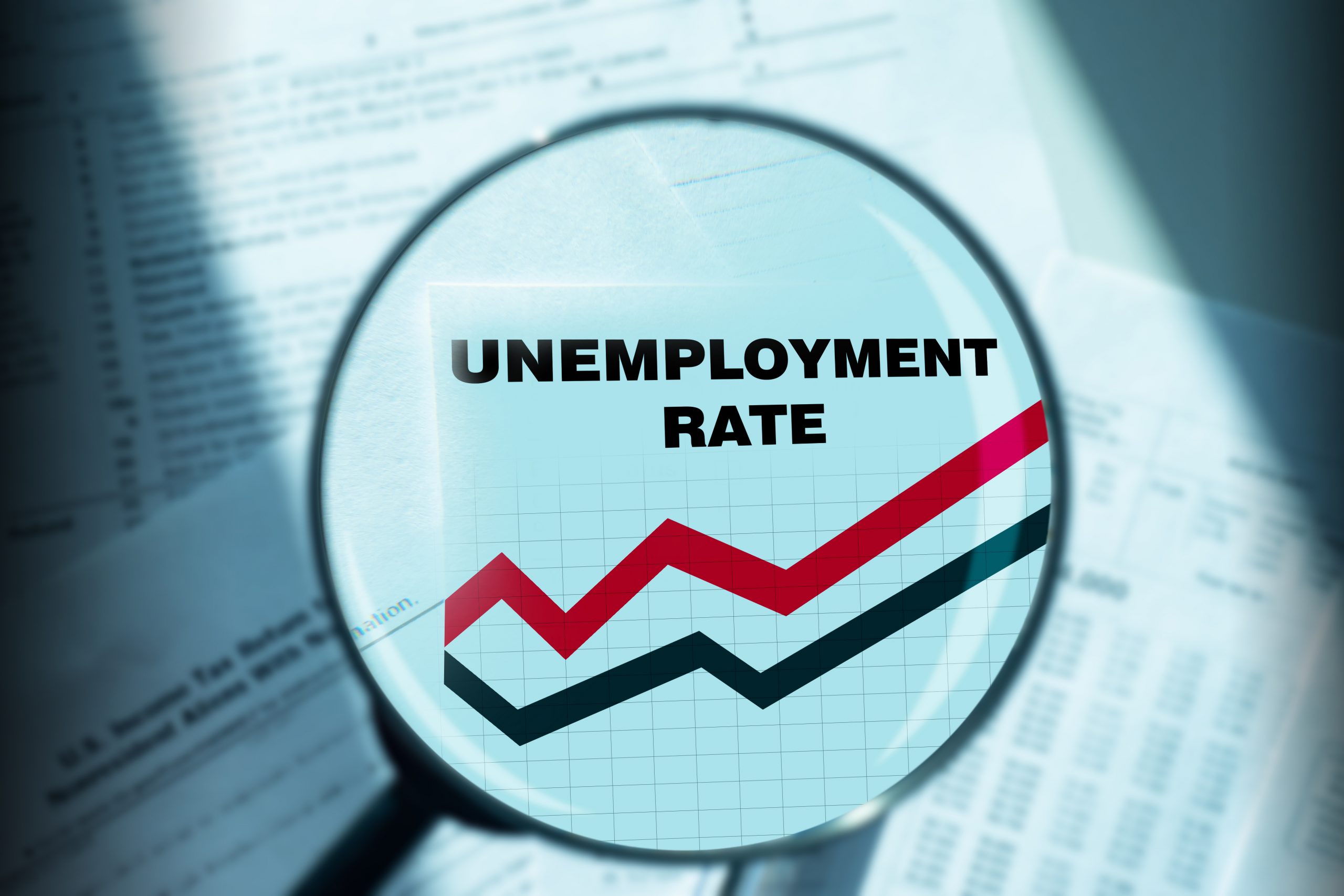SEIFSA responds to the draft Employment Equity sector targets
In response to a call for public comment the Steel and Engineering Industries Federation of Southern Africa (SEIFSA), representing 18 Employer Organisations, who collectively represent in excess of 1 300 companies, employing approximately 173 000 employees, submitted the following.
The metals and engineering sector is an integral part of the global and domestic economy. It constitutes 26% of the manufacturing and contributes 2.6% directly to the country’s gross domestic product (GDP). SEIFSA’s affiliated members in the sector constitute the entire metals value chain from metal production, merchants, metal fabrication, heavy and light engineering. The sub-industries that make up the sector are contained in the table below.
The sector is a crucial supplier of inputs into major sectors such as agriculture, mining, the automotive sector, construction and other manufacturing sub-industries.
The sector is also a strategic avenue through which the country converts its vast mineral endowment to final engineered products, domestically.
| Economic Variable | 2020 | 2021 | 2022 |
| M&E GDP (Rand billion) | R115.7 | R130.6 | R131.1 |
| Share of GDP | 2.5% | 2.6% | 2.5% |
| Capacity Utilisation | 66.6% | 75.5% | 75.8% |
| Employment (number) | 371955 | 371390 | 374496 |
| Total Sales (Rand billion) | R638.5 | R809.4 | R914.2 |
| Export Sales (Rand billion) | R256.1 | R323.5 | R342.9 |
Source: Statistics South Africa, SARS, MIBFA
Despite the potential of the sector, the graphs hereunder are the most effective way of communicating the distress that the sector has experienced over the last 15 years.
Production trends have been on a structural downward trajectory since the 2008/ 2009 global financial crisis, from which the sector has never fully recovered. The sector for all intense and purposes has been in a structural recession since 2008.
As is to be expected, the sector was not spared from the economic disruption of Covid-19. Whilst a sharp recovery has been noted, production levels are still 5% below pre-covid levels.
On the employment front, the sector has lost 205 926 jobs from the 2008 peak of 577 502 to the current employment count of 374 496. As the global economic environment deteriorates, more intense head-winds are anticipated for the sector.
With the official unemployment rate edging above 33% there seems little prospect for improvement in the near future, especially with loadshedding continuing to wreak havoc on our sector and the broader economy as a whole. The electricity crisis, resulting in up to 16 hours of electricity cuts for some industrial areas, eats into everything that powers an economy that has hardly grown for more than a decade. The number of unemployed people should instil a sense of urgency into fixing the economy. Failing that, we run the risk of entrenching the kind of poverty that can upend the social compact that underpins our democracy.
The metals and engineering sector is therefore in structural decline, both in terms of economic performance and employment. This presents a structurally constrained environment, one where opportunities for new employment creation is limited.
In setting the context, we refer to the graph on the previous page. You will note that not only has production in the sector averaged 15% below its 2008/9 peak, but it has also has recorded a multi-year contraction of - 1.3% (CAGR), over this period.
In 2023, SEIFSA estimates that production in the sector could contract by a further 5.3% if the impact of load-shedding is factored in. Moreover, production of the metals and engineering sectors is a function of economic activity and infrastructure spend, both of which have disappointed over the last 10-15 years.
The table below depicts the trends of both variables (GDP and gross fixed capital formation) over these periods. It is evident that the trends are deteriorating when the decade is compared to the 15-year period.
|
Variable |
10 years | 15 years |
| GDP Growth | 1.1% | 1.3% |
| Gross Fixed Capital Formation Total | - 0.9 | 0.8% |
| Gross Fixed Capital Formation General Government | -1.5% | 1.2% |
| Gross Fixed Capital Formation Public Corporations | -5% | 1.8% |
| Gross Fixed Capital Formation Private Sector | 0.2% | 0.6% |
| Construction Sector Activity | - 2.1% | 0.7% |
Source: Statistics South Africa
The above generally explains the resulting trends noted in the metals and engineering sector.
Another important point to highlight is the evident decoupling between production and employment trends. This relationship has continued to widen over the last 15 years. The current estimates indicate that it takes a five percent increase in production to induce a one percent increase in employment. Therefore, the context of declining production as already presented earlier, does not bode well for employment prospects.
SEIFSA’s submission is that in such an environment of structural decline and a limited market that is also shrinking, the sector is unlikely to attract new entrants and the transformation consideration has to be considered through this lens.
The economy is expected to flatline barely above recessionary territory on a medium-term basis, which will undoubtedly lead to the upending of businesses (large, medium and small) and prospects of employment opportunities. The combination of high inflation in a weak demand environment - which has a negative carry-on profit margins - and high interest rates – which are inversely related to new investment – the outlook for the sector is bleak.
The net effects, certainly in the short-medium term, will be that companies will simply be unable to meet the proposed sectoral targets, human capital and skills development will be severally hampered and so will the valuable and positive investments that companies have in community work, supplier development initiatives etc., with companies simply opting to closing shop.
The proposed sectoral targets have come as a surprise as the Amendment Act, although assented to earlier this year, is not yet in effect. The Regulations are therefore premature and, if challenged, may be considered ultra virus.
We are firmly of the view that the Department erred in halting the consultation processes it was busy following with the different Sub-Sectors and Sectors as provided for in the Act and publishing only Sector Targets for the main sectors in an attempt to hopefully achieve implementation of Sector Targets on 1 September 2023. By doing so, it has opened itself up to legal challenges, which will inevitably lead to this implementation date not being achieved and the process that the Department had quite rightly embarked upon, being further halted until the exhaustion of the ensuing legal proceedings.
This will, in all likelihood, result in the implementation of Sector Targets being delayed for far longer than it would have been, had the Department continued with its consultation processes and not tried to fast-track the implementation of Sector Targets on 1 September 2023.
The Department is therefore urged to reconsider this course of action and to firstly conclude the engagements and processes that started with the different Employer Organizations in the different Sectors and Sub-Sectors, before re-issuing Sector Targets.
Thought Leadership
Thought Leadership piece by Lucio Trentini, the CEO of the Steel and Engineering Industries Federation of Southern Africa (SEIFSA)
South African businesses in the metals and engineering (M&E) sector have faced enormous challenges over the past few years, with the Covid-19 pandemic compounding an already difficult situation.
A shrinking domestic market, declining production, weak production sales, a smaller contribution to the economy, increasing joblessness, cheap imports and low investment levels are just some of the issues they face.
These challenges do not plague the M&E sector only and their knock-on effects are felt throughout the economy due to its role as supplier and customer into the auto, motor, mining, construction and other manufacturing sub-industries.
Manufacturing companies play an integral part in the supply chain of the South African economy and the sector will struggle to recover without support. The sector already relies heavily on demand from Government projects to boost its production and sales, especially for products such as steel and other downstream products. This is why the Government must speed up the implementation of its infrastructure investment plan and reforms across state-owned enterprises (SOEs) as the lack of progress on these and other projects is delaying the revival of our economy.
Some form of protection against the dominance of imports while promoting domestic manufacturing and suppliers can also make a difference, though in the longer term the international competitiveness of the sector will need to improve before local producers can assume the role of preferred supplier to both domestic and international markets.
There is also help at hand in the form of the African Continental Free Trade Area (AfCFTA) agreement, which offers new opportunities for trade on the continent in the M&E sector.
Costs remain an issue for manufacturers. The unexpected acceleration in producer inflation in December highlighted the effect of higher energy prices globally and global supply chain problems. According to the latest data released by Statistics SA, the producer price index (PPI) for final manufactured goods rose 10.8% year on year in December, up from 9.6% in November. Stats SA said coke, petroleum, chemicals, rubber and plastic products were the main contributors to the higher number; these product categories incorporate petrol and diesel prices, which are close to record highs.
Manufacturers also have to contend with falling prices, which benefit buyers of the M&E sector’s products, but put enormous pressure on manufacturers' profit margins, which in turn leads to job losses as companies look for ways to cut costs.
SA’s official unemployment rate was recorded at 34.9% in the third quarter of 2021 — the highest jobless rate since comparable data began in 2008 — due to, amongst other things, the deplorable looting that took place in July compounded by the stringent lockdown measures.
The jobless data showed that 660,000 jobs were lost between the third and second quarters of 2021. The broader manufacturing sector lost 13,000 jobs. The disheartening lack of employment opportunities affects the economic status of the country and, more importantly, the livelihoods of all its people.
Industry has expressed its concern about the stubbornly high unemployment rate. The Steel and Engineering Industries Federation of Southern Africa (SEIFSA) has called on the Government to address the issue, while finding ways to reduce the cost of electricity, diesel and petrol to help put the economy back on track.
The M&E sector is a strategic industry for South Africa, so plans to reindustrialise the sector, including the primary steel and downstream industries that employ more than 200,000 workers must not be allowed to fail.
SEIFSA has advocated for infrastructure development as a means to promote industrialisation in South Africa, especially in the M&E sector as it feeds into infrastructure projects from an input supplier perspective, but for recovery to take place there is a need for clear purpose and strong support for Government projects.
While it is not possible to state, with a degree of certainty, how the year ahead is likely to pan out, it is probably safe to say that 2022 will be marginally better than 2021. However, a lot hinges on the Government’s planned infrastructure rollout and the trajectory the COVID-19 pandemic takes in the country in the months to come.
We hope that the Government will finally deliver on both the Steel Master Plan and the promised and long-awaited infrastructure plan, which is intended to stimulate the economy, and not be distracted by the political agenda when all focus and energy should be firmly directed at economic growth and recovery.
Producer price inflation (PPI) for intermediate manufactured goods remains unchanged
Johannesburg, 27 January 2022 - The Steel and Engineering Industries Federation of Southern Africa (SEIFSA) is pleased with the PPI for intermediate manufactured goods data, as reported by Statistics South Africa (Stats SA) today.
The latest data published by Stats SA indicates producer price indices which is a measure of the average change in the prices of goods either as they leave their place of production or as they enter the production process. PPI is used for a variety of purposes, such as: a short-term indicator of inflationary trends and for indexing long-term contracts to take the inflationary risk out of the contract in contract price adjustments.
The Stats SA data shows that on a year-on-year basis, the PPI for intermediate manufactured goods remains at 23.1 percent for December 2021. Economist at SEIFSA, Ms Molise stated that “the main contributors to the annual rate were: chemicals, rubber and plastic products, basic and fabricated metals and sawmilling and wood. While the PPI for final manufactured goods for the broader manufacturing sector also increased to 10.8 percent in December 2021, up from 9.6 percent in November 2021 on a year-on-year basis”.
Prices for intermediate manufactured goods, have increased from a low base in 2021 averaging at 16.2 percent. While the increase in prices for intermediate goods over the 12-month period in 2021 is relatively positive news for the producers of intermediate goods within the M&E sector in terms of increasing profit margins by passing cost increases to customers, however, in depressed market conditions, this may have negative implications in terms of affordability from a customer base perspective, Ms Molise said.
The increasing trend in PPI, tends to result in future inflationary pressure in the prices of consumer goods, as seen in the recent annual headline consumer price inflation (CPI) figures, coming at 5.9 percent in December 2021, up from 5.5 percent in November 2021, which is the highest annual increase since March 2017, indicating an increase in the cost of living.
For the period January 2021 to December 2021, PPI for intermediated manufactured goods data has significantly improved, which provided an opportunity for businesses to leverage in trading opportunities. With global producer price inflation rates increasing, as the global economy slowly picks up in 2022, the overall inflationary outlook domestically could pose as a concern at consumer level and at industrial production level as high unemployment rates, weaker exchange rate, rising fuel costs and escalating electricity costs continue to pose significant barriers to growth for the overall M&E sector.
BUSA on announcement by minister Pravin Gordhan on electricity market reforms
We support the comments made by two of our members, BLSA and Minerals Council SA, on
the announcement by Minister Gordhan that ESKOM will 36000 hectares of its land in
Mpumalanga to private sector generators of renewable energy. We also welcome the Minister’s
and ESKOM management’s announcement that they will expedite access to the grid by
independent power producers and other private sector players with the capability and capacity
to produce renewable energy.
It is exactly this type of partnership between the public and private sector that BUSA has been
appealing for in the course of the last 3 to 4 years. This initiative demonstrates the optimal
utilization of appropriate public and private sector infrastructure and capacity to address the
critical problem of energy supply. This is great for the economy, but also addresses the
frustrations of ordinary people who experience load shedding on a regular basis.
BUSA has consistently called for necessary structural reforms in the economy to attract
investment, put us on a sustainable inclusive growth path and address the socio-economic
challenges we have. President Ramaphosa’s announcement a few months ago that the ceiling
for embedded energy would be raised to 110MW was warmly welcomed by BUSA. The
announcement on Wednesday 15th December 2021 by Minister Gordhan and ESKOM begins to
give effect to the opening up of the energy sector to private sector players.
We also welcome this fresh and progressive approach from ESKOM. Andre de Ruyter has
consistently maintained ESKOM must facilitate the entry of private sector players ion the energy
market and enabling access to the grid of cleaner forms of energy. This announcement
demonstrates that ESKOM has finally adopted an approach that moves away from a
monopolization of the energy market. This is an essential step in applying the National
Integrated Energy Plan and puts us on the long hard road to sustainably addressing SA’s
energy crisis. This initiative must also be seen in the context of our country’s commitment to
zero emissions and is a step in that direction.
BUSA urges other SOE’s to follow the example set by Minister Gordhan and ESKOM. We
cannot, as a country, afford to waste resources and not use optimally all the capacity in the
public and private sector, to grow our economy and improve people’s lives. We are convinced
this type of a fresh approach from other critical SOE’s will unlock the full potential of the private
sector and send a clear signal that government is beginning to implement the structural reforms
urgently needed to attract investment and build our economy.
Eskom Group Chief Executive, André de Ruyter responds in an open letter to SEIFSA CEO
Load shedding and its impact of the metals and engineering sector
Eskom acknowledges your letter dated 23 November 2021.
The contribution of the Steel and Engineering Industries Federation of South Africa (SEIFSA) to the
employment and economy of the country is acknowledged. Eskom has had a good relationship
spanning over many years with the key industrial customers represented by your federation, and
such industries have always complied with the NRS 048-9 agreement to curtail load whenever
Eskom declared a power system emergency.
While Eskom regrets the electricity supply interruptions in the past weeks, it is important for SEIFSA
to understand that load shedding is the last resort in the management of the power system. This is
to protect and prevent the power system from collapsing or even having a black-out.
Eskom forecasts potential load shedding based on the maintenance plan and an assumed amount
of unplanned unavailable generation capacity; 11 000 MW in the winter and 12 000 MW in the
summer months (the base case). Eskom then adds two risk scenarios by adding an additional
1 000 MW and 2 000 MW to this assumption.
For the base case, the current forecast is two days of Stage 2 load shedding for the next year. For
the + 1 000 MW risk case, this rises to 104 days of up to Stage 2 load shedding and for the + 2 000
MW risk case; 252 days of up to Stage 3 load shedding. Eskom, however, endeavours to keep the
unplanned losses to below even the base case. It is essential that, for sustainable performance
improvement, Eskom continues to implement its reliability maintenance programme and to keep in
mind that 4 000 MW to 6 000 MW additional national capacity is required to significantly reduce the
risk of load shedding.
I welcome SEIFSA’s availability to assist Eskom in any way possible, and would therefore like to
propose that together with some of my executive team, we have a meeting with you and your team
to discuss ways to reduce the impact of load shedding on your federation member companies.
My office will be in contact with yours to make this arrangement.
Yours sincerely
André de Ruyter
GROUP CHIEF EXECUTIVE
SEIFSA CEO Message
I write this message toward the end of an extremely challenging year not only for SEIFSA and its affiliated member companies, but also for the South African economy. The socio-economic aspirations of millions of South Africans, particularly of those on the fringes of the formal economy have taken a knock.
As such, with the culmination of 2021, we assume a reflective posture on the damage visited upon the economy and the socio-economic fibre of the country primarily by the unrelenting COVID-19 pandemic, the July unrest as well as the recent three-week strike in the metals and engineering sector. It sure does seem that there is very little to celebrate about the state of country and economy at this stage with very few glimpses of a promising socio-economic outlook.
It bears revisiting the damage caused by the COVID-19 pandemic on the lives of millions of South Africans. In the past, we have dealt a lot on the economic repercussions of the ongoing pandemic. However, we are beginning to take a lot more seriously the impact of the pandemic on human life and psyche. As a sector, we are deeply indebted to the hundreds of thousands of workers who have braved the frontline while dealing with the scars of the pandemic which has affected them directly and indirectly. They have shown remarkable resilience while companies have been forced to lay-off workers because of the pandemic. I am particularly pleased by the support of employers in the sector which they have extended to their workers in confronting the socio-economic ravages of the pandemic.
Similarly, the recent looting and unrest in July which affected mainly the economic hub of Gauteng and KwaZulu/ Natal did very little to quell and calm the jitters of investors as economic infrastructure was decimated in full view of the world’s eye. This has dealt untold socio-economic harm to the economy and on the businesses of our membership. We will continue to support our members which have been affected by the looting episode to ensure that they are able to revive operations and that they are on the road to a more prosperous future.
There seems to be no real silver lining in the horizon! However, the status quo demands an optimistic citizenry and cadre of entrepreneurs that will drive the change we wish to see. But, there are small, encouraging but minute signs of economic recovery as fresh economic data emerges.
Statistics South Africa recently stated that he South African economy recorded its fourth consecutive quarter of growth, expanding by 1,2% in the second quarter of 2021 (April–June). This followed a revised 1,0% rise in real gross domestic product (GDP) in the first quarter (January - March). Despite the gains made over the last four quarters, the economy is 1,4% smaller than what it was before the COVID-19 pandemic.
These figures cover the months of April, May and June. This means that the economic impact of the wave of severe economic disruption in KwaZulu-Natal and Gauteng, will only reflect in the third quarter GDP results that are due for release in December.
While the StatsSA figures indicate a sudden drop in economic activity during the second quarter of 2020 when lockdown restrictions were at their most severe, the economy has seen consistent growth since that shock, but not enough to return to pre-COVID-19 levels. Real GDP was R1 131 billion in the second quarter of 2021, 1,4% down from the reading in the first quarter of 2020.
Perhaps more daunting was the recent three-week strike which saw thousands of workers in the sector lay down their tools in order to demand a ‘better’ wage deal for themselves. The team at SEIFSA pulled out all the stops to ensure that a fair deal was achieved for employers.
I am grateful to the SEIFSA team for their unfailing dedication during a very stressful time. I am equally thankful of the Associations for their contribution, support and understanding in supporting a fair deal which protects the interests of employers and employees. I also extend gratitude to employers for their patience in a difficult negotiation environment.
We are also mindful that strikes rarely benefit any party. Workers take a knock on wages and some lose their jobs while employers lose millions in lost production and revenue. To arrive at a workable and fair deal, requires the effort of all parties on both ends of the negotiating table to negotiate in good faith and in the interests of the industry. We are thus thankful to all the unions for their dedication in doing their share to finding a just and fair deal for all.
SEIFSA is pleased that it has concluded a good deal for its members which has resulted in the constitution of a three-year wage deal which guarantees industrial relations peace, certainty and stability for all member companies until 30 June 2024. The deal was struck on 21 October 2021 on behalf of all SEIFSA’s affiliated member companies.
This agreement followed a challenging negotiation and dispute-resolution process which comprised several formal, informal and bilateral meetings which commenced in May and ending with NUMSA signing the Settlement Agreement ending the three-week strike.
From a SEIFSA perspective and that of its Associations and membership, we are doing our bit in helping revive the fortunes of a manufacturing sector which finds itself in a precarious position. Recent manufacturing data is pointing towards the promise of an upward trajectory in the sector which should bode well for growth, improved revenue generation and sustainable jobs within the sector. We will continue to empower our Associations with support tools and interventions which should translate to a resilient membership base which continues to navigate and negotiate what is undoubtedly treacherous economic terrain.
We wish all our members, Associations and stakeholders a joyous and safe festive season as most companies approach the year-end shutdown. We are pleased to have travelled this journey with you in 2021 and we look forward to more support and collaborative energy in tackling the challenges facing the industry. I remain optimistic that 2022 will be a far better year than the one we have survived, with hopefully sustained growth and uninterrupted production being the order of the day for all of us!
SEIFSA concerned by further rise in unemployment numbers for the third quarter of 2021
Johannesburg, 29 November 2021 - The Steel and Engineering Industries Federation of Southern Africa (SEIFSA) is concerned by data released by Statistics South Africa (Stats SA) today, showing a further increase in the unemployment numbers in the domestic economy.
According to the latest Quarterly Labour Force Survey (QLFS), the data indicates that there is an increase in the unemployment numbers in the broader domestic economy on a quarter-on-quarter basis from 34.4 percent in the second quarter of 2021, to a high of 34.9 in the third quarter of 2021. This is the highest unemployment rate since 2008. The concerning unemployment numbers reflects the impact of Covid-19, stricter lockdown measures, the July riots and overall depressed economic activity across all major economic sectors.
SEIFSA Economist Palesa Molise noted that on aggregate, the data shows that 660 000 jobs in total were lost on a quarter-on-quarter basis between the third quarter of 2021 and the second quarter of 2021. The broader manufacturing sector (including its heterogenous metals and engineering (M&E) sector), lost 0.9 percent of total employment, which equates to 13 000 jobs lost between the second and third quarter of 2021, whilst the number of employed people decreased from 1 415 000 to reach 1 402 000 during the same period. Disconcertingly, on a year-on-year basis, the manufacturing sector lost an alarming 58 000 jobs, representing a decline of 4.0 percent.
“All industries experienced job losses between the second and third quarter of 2021, except for the Finance Industry which gained 138 000 jobs” Ms Molise said.
Ms Molise said that the surge in unemployment numbers, coupled with a very high Gini-coefficient of 63.0 index in South Africa, is worrisome as this indicates the extent to which inequality is deepening in the country. The issue of unemployment or rather the lack of employment opportunities continues to affect not only the economic status or progression of a country but more importantly the livelihoods of all its people.
Ms Molise added that “More effort should be placed in curbing the stubbornly high unemployment rate, reducing electricity costs, logistical costs and providing for critical skills opportunities in digitisation, automation, data science and artificial intelligence.”
“The latest unacceptable rise in unemployment figures, now more than ever before, requires Business, Labour and Government to urgently collaborate in finding sustainable solutions to the scourge of unemployment in our Country.” she concluded.
SEIFSA encouraged by continous improvement in selling price inflation
Johannesburg, 25 November 2021 - The Steel and Engineering Industries Federation of Southern Africa (SEIFSA) welcomes the continued improvement in the Produce Price Index (PPI) for intermediate manufactured goods, as reported by Statistics South Africa (Stats SA) today.
“PPI data has improved consecutively from January this year, alongside the PPI for final manufactured goods. This is good news for the broader manufacturing sector and specifically the Metals and Engineering (M&E) sector against the backdrop of the coronavirus pandemic, lootings, industrial action and increased volatility in imported prices as a result of a generally weak exchange rate”, says SEIFSA Economist Palesa Molise.
The Stats SA data shows that on a year-on-year basis, the PPI for intermediate manufactured goods increased to 20.4 percent in October 2021, from 19.5 percent in September 2021. The main contributors to the annual rate were: chemicals, rubber and plastic products, basic and fabricated metals, saw-milling and wood. PPI for final manufactured goods for the broader manufacturing sector also increased to 8.1 percent in October 2021, up from 7.8 percent in September 2021 on a year-on-year basis.
“Given that the PPI for intermediate manufactured goods has maintained an upward trajectory since January 2021, an increasing trend in the PPI for intermediate manufactured goods bodes well for the broader manufacturing sector. This assist businesses to be more competitive considering that businesses have been struggling with increases in input costs. Rising fuel prices and energy costs remain a concern, especially given the current challenging economic environment, characterised by weak domestic demand and declining employment numbers. Better PPI for intermediate manufactured goods amounts to some good news for producers in the M&E sector, who now have some lee-way to recover the losses incurred as a result of volatile input costs which will add to the bolstering of margins”, said Molise.
During this immediate period of recovery from the recent industrial action in the steel and engineering sector, businesses will be seeking to leverage off the improvement in selling price inflation amidst the on-going uncertainties around a possible fourth wave, on-going and intermittent load-shedding and the possible reintroduction of harsher COVID-19 adjustment levels.
SEIFSA open letter to Eskom CEO
Load shedding and its impact of the metals and engineering sector
I write to you on behalf of eighteen employer associations, who are federated to SEIFSA, who collectively represent in excess of a thousand employers and who employ close to 170 000 employees, which accounts forty-percent of all employees in the metals and engineering (M&E) sector.
The metals and engineering sector is a key and integral part of the economy. Any disruptions in the sector’s industrial activity feeds through into the rest of the economy. From the end user’s perspective, the M&E sector, made up of 13 sub-sectors, is a crucial supplier of inputs into major sectors such as construction, mining, motor, automotive and other manufacturing sub-industries.
Notwithstanding the COVID-19 pandemic, the economy was already suffering from a shrinking domestic market, declining production, low capacity utilization, weak production sales, declining employment numbers, increasing levels of imports, a weak global trade balance and low investment levels.
In the first six months of 2021, green-shoots began emerging in the sector. Key positives during this period were improvements in production volumes and production sales, capacity utilization, exports improving in value terms, narrowing of the M&E trade deficit and growing exports into the African continent.
The M&E sector, already buckling under the strain of difficult market conditions, state capture, low economic growth, disinvestment and collapsing infrastructure, misguided objectives and parochial interests, is now having to contend with seemingly never-ending load shedding.
Whilst we accept that structural changes, significant investment and a culture or paradigm shift is urgently needed to secure the long-term sustainability of Eskom, in the immediate to medium term, on-going and intermitted load shedding is taking a heavy toll on our membership, the sectors contribution to the fiscus and the M&E sector’s ability to hold onto jobs and more importantly, create additional and much needed employment opportunities.
I have no doubt that you have heard more than your fair share of horror stories about the effect of load shedding on businesses. The sad and tragic reality is that it has gone on for so long that we have become accustomed to wringing our hands in despair and hoping for the best. It is also true that much has been written regarding the negative effect of load shedding on industry, sadly with little effect. Repeated assurances that everything possible is being done is also wearing thin on business.
We continue to hear and read about Eskom blaming its aging fleet on its poor performance. Whilst we may, readily accept this, we are also of the view that this, may, with respect, be an oversimplification of the problem. Moreover, much has been written about the lingering and worrying effects of the deep-rooted networks of corruption within Eskom and your commitment to eradicating this and returning this once great institution to good governance, which endeavours we support. We also support the Presidents call and your commitment to Eskom’s division into three constituent parts (generation, transmission and distribution) each run on sound businesses practices.
In closing, as we continue to struggle with the reality of load shedding, which we reluctantly have no choice but to accept for the foreseeable future, can you provide business with assurances that firstly, the scourge of corruption is being tackled and criminal and/or civil charges against current and past employees have been opened with the South African Police Services and how many of these cases have resulted in convictions; secondly, do you have the political leeway to make the cultural and headcount changes necessary to make Eskom a viable commercial enterprise and finally, are you able to provide businesses with assurances on predictability going forward? It is incredibly difficult for businesses to plan production and/ or give assurances to customers and clients when load shedding schedules themselves are not predictable.
South Africa and for that matter SA Inc., cannot afford for Eskom to fail. All we ask is that, as business continues to grapple with the present-day reality, you and your team are doing everything reasonably possible to address this crisis.
Business needs to know that the sacrifices we make today, will yield the returns that will contribute to putting SA Inc. back on a positive growth trajectory fuelled by a stable and predictable energy supply.
SEIFSA and its constituent membership remain available to assist you in your endeavours in whatever way we can, as you and your team steer Eskom, and for that matter SA Inc., through this crisis.
I look forward to receiving your views herein.
Yours Faithfully
Lucio Trentini
Chief Executive Officer
SEIFSA welcomes finance minister’s 2021 medium term budget policy statement
JOHANNESBURG, 12 NOVEMBER 2021 – The Steel and Engineering Industries Federation of Southern Africa (SEIFSA) welcomes Finance Minister Enoch Godongwana’s Medium Term Budget Policy Statement (MTBPS), which outlined South Africa’s path to economic and social recovery.
The year 2020 has been difficult for South Africa’s ailing economy which was not spared from the devastating impact of the global coronavirus pandemic. However, as noted by the Minister of Finance in his speech, the first half of 2021 indicates a path to recovery which has been characterised by lower interest rates, support from strong international demand and higher commodity prices. This is in line with the significant green-shoots we have seen in the broader manufacturing sector and in the Metals and Engineering sector. The MTBP identified the need to manage our debt and for the faster implementation of structural reforms. These should create an environment for investment growth to ensure a fast-growing economy.
As one of the sectors which form the backbone of the South African economy, the Metals and Engineering sector remains a crucial supplier of inputs into major sectors such as construction, mining and other manufacturing sub-industries. It is thus an integral part of economic and industrial development in South Africa. Therefore, infrastructure opportunities through the Economic Reconstruction and Recovery Plan will assist the ailing sector in its recovery.
We applaud the Minister for noting the continued commitment to the Infrastructure Fund which should unlock more infrastructure projects for implementation. It places special emphasis on fiscal sustainability and on economic reforms which are focused on improving competitiveness, productivity, investment and employment. These are extremely crucial for the South African economy, and for the Metals and Engineering sector in particular.
Against the backdrop of the coronavirus, the persistent erratic electricity supply, increasing cost of living and local steel prices and the increase in fuel prices poses challenges to economic recovery. Therefore, more work needs to be done as it would take time before the economy can be turned around.










